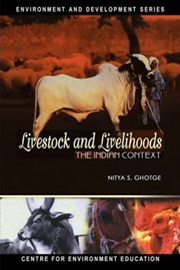Book contents
- Frontmatter
- Foreword
- Acknowledgements
- Contents
- Preface
- Chapter 1 The Beginning …
- Chapter 2 Patterns of Livestock rearing
- Chapter 3 Traditional Practices in Animal Rearing
- Chapter 4 Emerging Trends in Livestock Rearing
- Chapter 5 It must not End: Towards an Alternative Policy
- Chapter 6 Reorienting Ourselves
- Chapter 7 Framework for An Alternate Policy
- References
- Index
Chapter 5 - It must not End: Towards an Alternative Policy
Published online by Cambridge University Press: 26 October 2011
- Frontmatter
- Foreword
- Acknowledgements
- Contents
- Preface
- Chapter 1 The Beginning …
- Chapter 2 Patterns of Livestock rearing
- Chapter 3 Traditional Practices in Animal Rearing
- Chapter 4 Emerging Trends in Livestock Rearing
- Chapter 5 It must not End: Towards an Alternative Policy
- Chapter 6 Reorienting Ourselves
- Chapter 7 Framework for An Alternate Policy
- References
- Index
Summary
We hope that the concluding paragraph of the previous chapter is not our destiny and that the powers of reason will steer us clear of a singular path of destroying all that is valuable. We hope that our history and our traditions will give us the stimulus and the opportunity to explore different ways.
The enormous diversity in our country and our culture are in fact the main keys, which can prevent humans from becoming automated robots and animals or becoming production factories. For all those who believe that being pro-environment is being anti- development, the converse in fact is true. Preserving the environment and the diversity within would lead us on a development path which is more humane, ultimately more sustainable and viable.
Exploring Diverse Ways …
When we talk of diversity in the context of livestock rearing, we do not merely talk of diversity in livestock species, breeds and produce but have to extend the idea to diversity of resources, patterns of rearing, and other aspects which have a direct or indirect bearing on the welfare of animals.
Diversity of livestock species: mixed farming systems
There is enormous sense in mixed or multi-stocking.
The different animals do not compete for the same resources in a particular area. For instance in an arid area if sheep and camels are raised together, the flock of sheep should be made to graze on the grass while the camels consume tree leaves. This prevents overgrazing of a particular type of fodder.
[…]
- Type
- Chapter
- Information
- Livestock and LivelihoodsThe Indian Context, pp. 100 - 107Publisher: Foundation BooksPrint publication year: 2004



